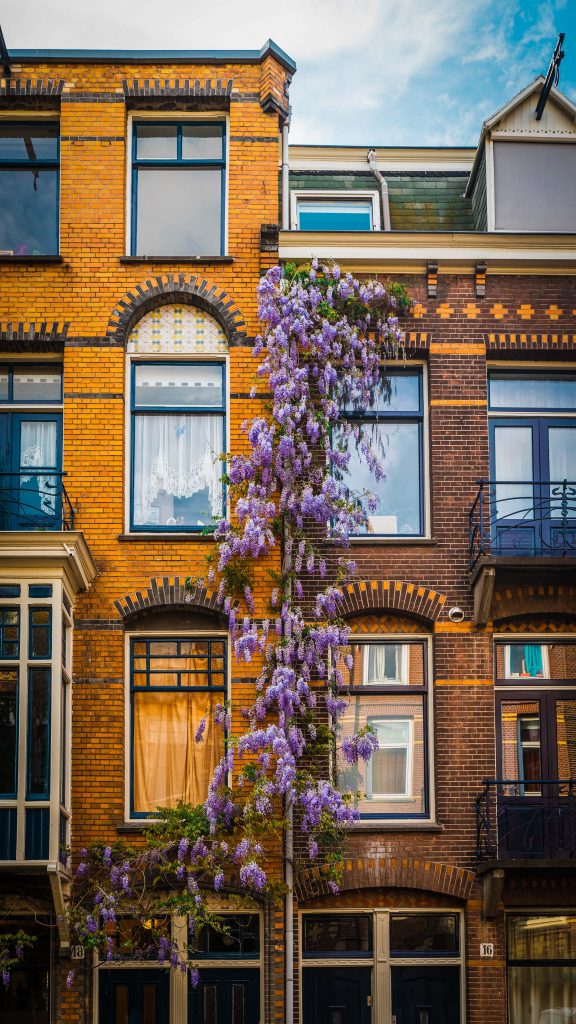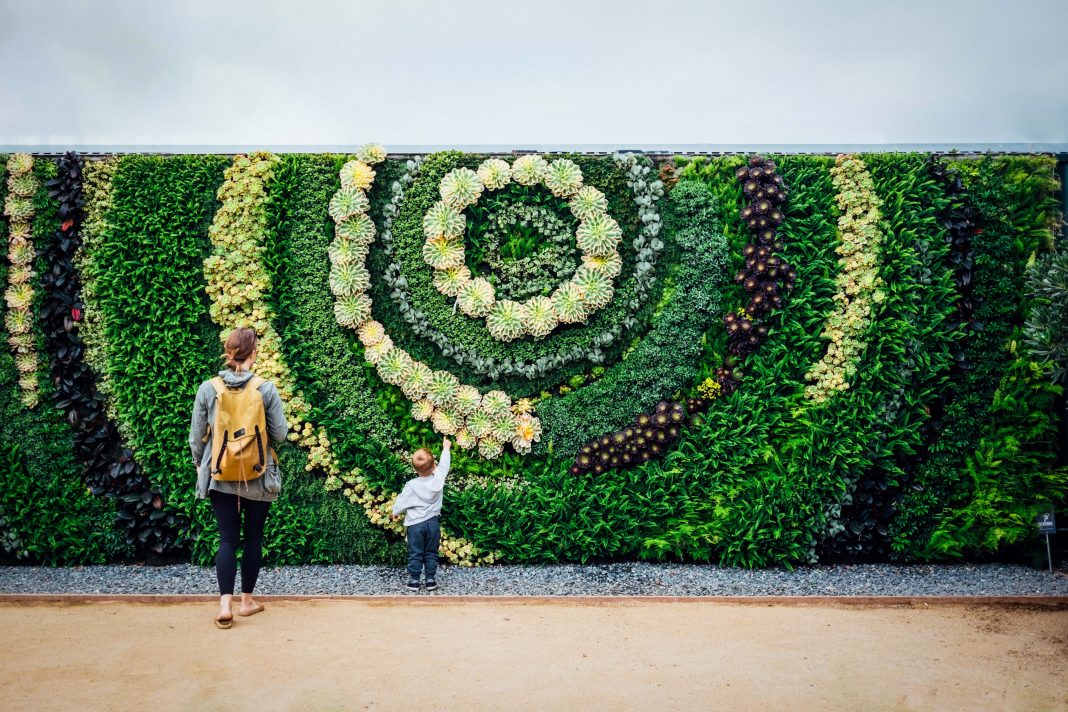Greening your walls just may be easier than you think. We have gathered guidelines, recommendations, costs, benefits, and everything you need to consider in this compact, easy-to-follow guide.
Whether you’re a lover of vegetation or simply want to do something good for the environment around you, green walls surely won’t disappoint anyone. With green facades gaining more traction and popularity, it’s easy to want one for yourself as well. Follow the steps below, and you could be a proud owner of one in no time.
1. Decide on a Type of a Green Wall
Green walls are vertical surfaces partially or fully covered in vegetation and can be indoors or outdoors. There are two types of green walls to take into consideration when deciding on which one to choose:
Green Facades
Are walls covered with climbing or cascading plants, which can be planted (and climbing) directly on the wall, or with supportive frameworks right next to the wall.
Living Walls
Also referred to as biowalls or vertical gardens, these consist of three parts: a metal frame, PVC layer, and an air layer.
Because they support a variety of plants and can hold more vegetation, living walls need more protection than green facades.
2. Choose a Spot & a Medium
Consider whether you want to green an exterior or interior wall. If outside, make sure plants will receive enough sunlight, if inside, you can use artificial light to replicate the exposure to the sun.
Plants for living walls need a medium to root into, which is placed on the structure:
- Loose growth medium: means the soil is put in a box or a bag and placed on the wall. Soil, hydro and volcanic stones or hydroponics are typically used for growing plants.
- Mat media: is usually made of thin coir (coconut) fibre or felt, with the plants growing directly on the mat, without the need for soil or stones.
- Sheet media: is similar to mat media but made of “inorganic polyurethane sheets more durable than coir fibre or felt.”
- Structural media: is a combination of mat and loose media, forming a block of different varieties.
3. Decide on an Irrigation System
Because plants need water and nutrients to survive and thrive, most green walls have an irrigation system installed. It can be either recirculating or direct. The former uses (and reuses) water from a built-in tank, and the latter collects water from an external source, sending the excess water to a sewer drain.
4. Choose Plants
Deciding on which plants to plant is the best part – that’s what green walls are all about. Naturally, you would want to pick the most vibrant and beautiful ones, but don’t forget about taking other factors into consideration too (such as shading, watering, climate, etc.). Some of the variants you could choose from are listed below.

Best – or recommended – plants for green facades include:
- Chinese Trumpet Vine: easy to propagate; blooming flower.
- Fortune’s Spindle: can be used as a herb.
- Common Ivy: good climber.
- Japanese Morning Glory: blooming flower; can be used as a herb.
- Japanese Honeysuckle: blooming flower; can be used as a herb.
- Blume: fast-growing climber.
- Chinese Firethorn: easy to propagate; anti-pest; blooming flower; can be used as a herb.
- Star Jasmine: fragrant and blooming flower; can be used as a herb.
- Chinese Wisteria: blooming flower; can be used as a herb.
Best – or recommended – plants for living walls include:
- Erigeron: easy to take care of; grows in sun or part shade; attract bees and butterflies.
- Gaillardia: grows in full sun and well-drained soil; attract butterflies.
- Heuchera: prefer part shade and moist but well-drained soil.
- Honeysuckle: grows in sun and moist, well-drained soil; attract beneficial insects.
- Hops: grows anywhere; good climbers; grow clockwise around the support.
- Laburnum: needs a well-drained spot with light soil; beautiful (but toxic).
- Marjoram: grows in full sun and well-drained soil; can be used as a herb.
- Pachysandra: grows in the shade; hardy; drought-resistant; pest and disease-free.
- Pelargoniums: grows in sun or part shade; adds bright colours.
- Strawberries: grow in sunny and sheltered spots; need well-drained soil; can be eaten.
- Thyme: easy to take care of; disease-free; aromatic leaves; grows in full sun and well-drained soil; can be used as a herb.
- Vinca Minor: fast-growing; grows in shade or part-shade.
EPA advises planting vines to the west, as it’s most effective for cooling a building, especially if they shade windows as well.
Keep in mind that when plants die it’s important to remove them, including their roots, to prevent plant diseases. Usually, up to 5% of plants growing on green walls die every year. It’s good to note the typical weather conditions prior to designing the wall – especially for outside walls.
All that said, taking the building’s structure into account is just as important. The walls of the building must be studied and included in the planning of the green facade to understand which models of urban vegetation it can support.
5. Apply the Structure
You’ve successfully gone through the four steps, now all that’s left is rolling up your sleeves and getting your hands dirty. Here is an easy-to-follow guide on how to do it:
Benefits of Green Wall Installation
So why should you decide to green your wall? Among others, advantages of having a vibrant facade rather than a grey one, include:
Reduced Heat Island Effect
By putting green facades in place in an urban canyon, temperatures can decrease by up to 8.4°C.
Vegetation can reduce the urban heat island effect by providing shade, through evapotranspiration, and by plants reflecting or absorbing up to 80% of sunlight; thus reducing the building’s temperature fluctuations by 50%.
Reduced Heating Demand During Winter
Cold wind plays a huge part in the effectiveness of insulation. With vegetation, the building is more protected from the wind and can reduce the heating demand by up to 25%.

Air Purifying
Plants on walls remove carbon dioxide, carbon monoxide, and other toxins from the air. Reducing CO2 levels and purifying the air is not only healthier for us, but also an environmental priority.
Additionally, they suppress dust particles, lowering the risk of respiratory illnesses.
Increasing Biodiversity
“Living walls not only increase the biodiversity of an urban space with plants, they offer vital nesting space, shelter and food for birds and insects,” reports Biotecture, adding that within days of installing green walls, bees and butterflies can appear occupying the plants.
Noise Reduction
Wall vegetation has low noise reflectivity and reduces outside sounds for residents inside the building.
Feeling Good
Plants affect the residents in a calm and positive way – they reduce stress, increase productivity and possible recoveries. And with their pleasant look, they conceal unattractive builds.
What to Expect – Moneywise
And when it comes to costs? Prices of green walls vary, depending on which medium, which irrigation system, and which plants you choose. The most affordable option is a small green wall with loose media and a simple irrigation system.
The average prices of green walls in both the US and the UK are around €150 per m2. For the maintenance (replanting, weeding, and watering), the monthly price is around €12.
Concerning the replanting – as the Green Roof Guide puts it in simple terms: if you have 100 plants on your wall, and 5% of them die, you replace them with new ones (paying ca. €5 for one), your average yearly cost amounts up to ca. €25.
Facades in Real Life
We wouldn’t be CityChangers if we didn’t provide you with some examples, show you how it works in reality, prove to you that it can be done. Below are two of the most impressive examples worldwide of large green wall installations.
Kaohsiung, Taiwan

Kaohsiung, Taiwan, currently holds the Guinness World Record for the largest green wall. With its 2,593.77 m2in size, it was designed by Cleanaway Company Limited and Shine Green Energy Enterprise Co., Ltd. in 2015 with the goal of camouflaging a landfill site.
Bogotá, Colombia
Another example is Santalaia, a multi-family residential building in Bogotá, Colombia, which measures 3,117 m2. “115,000 plants equal a carbon footprint compensation for 700 people; 3,000 m2 of vegetation provide oxygen for 3,000 people; and the very large Santalaia green wall offers the equivalent of air cleansing for the PMM emissions of 745 cars,” informs Greenroofs.com.
How to in a Nutshell
Greening your wall takes five simple steps:
- Deciding on a type of green wall
- Choosing a spot for it and deciding on a medium to support it
- Choosing an irrigation system to keep the plants alive and well
- Picking out the flowers
- Installing it
Green walls are an investment, but an investment in a greener environment. With benefits like purifying the air, fighting the heat island effect, and being aesthetically pleasing, who could resist? These benefits can be further amplified by installing a green roof – here’s how.


